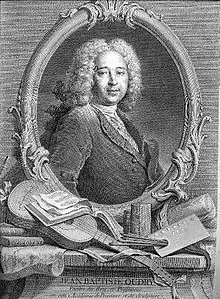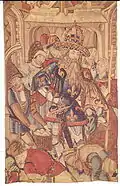
Le Cheval Fondu Tapestry, from the Barlatier de Mas Collection, Sotogrande, Spain

Jean-Baptiste Oudry, etching made by his wife, Marie-Marguerite Froissé, after a painting by Nicolas de Largillière.
The Pastoral Amusements, (French: Les Amusements champêtres) is a series of tapestries designed between 1720 and 1730[1] by Jean-Baptiste Oudry for Noël-Antoine de Mérou, then director of the Royal Beauvais Tapestry Manufactory. The first production of the designs took place at Beauvais in 1731.[2] After enjoying huge success the series was later adapted and further developed at Aubusson by Jean-Baptiste Huet the elder (d. 1811).
There are eight designs in the original series
- Le cheval fondu
- Colin-maillard
- La Bergère
- Le pied de Boeuf
- Le joueur d'Osselets
- La Balançoire
- Le joueur de broches
- Le joueur de musette
References
- J. Badin, Tapisseries de Beauvais, Paris, 1909
- D. Chevalier, Tapisseries d'Aubusson et de Felletin, Paris, 1988
This article is issued from Wikipedia. The text is licensed under Creative Commons - Attribution - Sharealike. Additional terms may apply for the media files.
